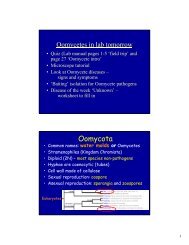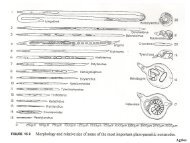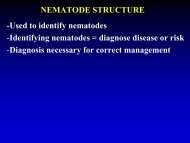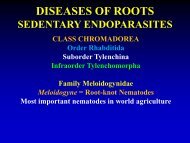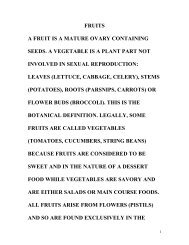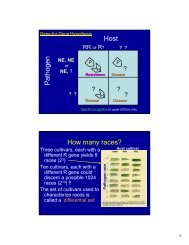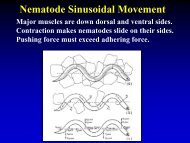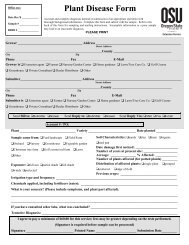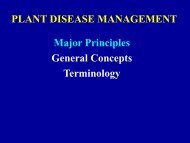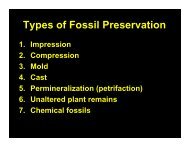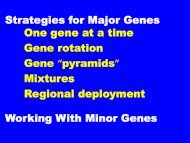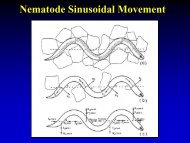PLANT RESISTANCE TO NEMATODES
PLANT RESISTANCE TO NEMATODES
PLANT RESISTANCE TO NEMATODES
- No tags were found...
You also want an ePaper? Increase the reach of your titles
YUMPU automatically turns print PDFs into web optimized ePapers that Google loves.
<strong>PLANT</strong> <strong>RESISTANCE</strong> <strong>TO</strong> NEMA<strong>TO</strong>DESResistant cultivars can be very effective for nematodecontrol but few have been developed so far.Breeding efforts are ongoing so you must check in yourarea to see if acceptable resistant cultivars are availablefor your crop of interest.ExamplesStem nematode in alfalfaSoybean cyst nematode in soybeanSusceptible varieties of woody plants can often begrafted onto resistant rootstocks (usually M. incognita).
ADVANTAGES <strong>TO</strong> USING RESISTANT <strong>PLANT</strong>S1. Compared to chemical controla. No residue concerns in food.b. No environmental concerns.c. Effective for life of plant.d. Economical = there is little additionalexpense to the grower, however, seed maybe a little more expensive.
ADVANTAGES <strong>TO</strong> USING RESISTANT <strong>PLANT</strong>S2. May be combined with resistance to other pests(insects, pathogens)= "built-in control".3. Resistance in one crop will reduce nematodepopulation increase and help controlnematode problems on next crop in therotation for which resistant cultivars may notexist.
PROBLEMS WITH <strong>PLANT</strong> <strong>RESISTANCE</strong>AS A MANAGEMENT STRATEGY1. Resistance is not necessarily a permanent solution.Nematodes may respond to selection pressureto develop biotype/pathotype/race that cansuccessfully attack resistant cultivar.
PROBLEMS WITH <strong>PLANT</strong> <strong>RESISTANCE</strong>AS A MANAGEMENT STRATEGY2. Similarly, the use of a cultivar resistant to onespecies may select for another species (or race).M. arenaria is usually not abundant on soybeanwhen M. incognita is present and was not generallyconsidered to be an important pathogen of soybean.Wide use of soybean cultivars resistant to Meloidogyneincognita has been responsible for population increasesin M. arenaria, which was normally outcompeted byM. incognita. Now M. arenaria is recognized as animportant pathogen on these cultivars.
PROBLEMS WITH <strong>PLANT</strong> <strong>RESISTANCE</strong>AS A MANAGEMENT STRATEGY3. Resistant cultivars may have other problems.Example = alfalfa resistant to Ditylenchus dipsaci.Talent = susceptible to bacterial wilt and notwinter hardy.Nemastan = poor forage and seed producer.Washoe and Lahontan = do not yield as well assusceptible varieties (without nematodes)
PROBLEMS WITH <strong>PLANT</strong> <strong>RESISTANCE</strong>AS A MANAGEMENT STRATEGY4. Often only a percentage of the plants in apopulation are resistant.5. Resistance (or tolerance) may only be partial.Therefore, resistant cultivars may produce“adequate” yields in the presence of nematodes butthese yields may still be less than for a susceptiblecultivar if nematodes were not present.
Resistance TerminologyPlant resistance to nematodes concerns:Host efficiency for nematode reproduction andHost sensitivity to nematode damage.
Host efficiency is usually described in terms of theReproductive Factor or Reproductive Index "R".R = Pf/Pi; where Pi = the initial populationand Pf = the final population.For R = 1, Pi = Pf -> maintenance line,plant is a marginal host.When R < 0.1, plant is a nonhost.When 0.1 < R < 1, plant is a poor host,When R > 1, plant is a host,the higher the R value = the more suitable the host.
Resistance TerminologyTerms which characterize host efficiencyImmunity = nonhost = no reproduction (R = 0)Resistance (incompatibility) - little reproduction(R < 1); little plant damage or growth reduction.Susceptibility (compatibility) - good reproduction(R > 1); plant may or may not be damaged.
Resistance TerminologyTerms which characterize host sensitivityTolerance - reproduction occurs (R > 1)but plant is not seriously damaged.Intolerance - reproduction occurs (R > 1)and plant is damaged.Hypersusceptible - little reproduction (R < 1)but plant is still damaged.
When a plant responds to inhibit a nematode, theresponses are characterized as mechanisms of“resistance” and are measured by the ability (orinability) of the nematode to grow and reproduce.If the plant responds to nematode disturbance(nematode feeding or invasion) by compensating forthe damage produced by the nematode so that theeffect of the nematode is reduced, this is referred toas “tolerance”.
A reduction in plant damage due to nematodesmay be due to "resistance" or "tolerance",but often the term resistance is loosely used foreither case.***resistance and tolerance may be underseparate genetic control.***Just need to remember that:Resistance/susceptibility relates to reproduction.Tolerance/intolerance relates to damage.
Resistance is in fact a continuum and includesanything between an immune plant and a susceptibleplant. Thus, the degree of resistance varies.In addition, a plant may be resistant to one nematodebut susceptible to others or it may have "common"resistance to many nematodes.Resistance properties are often very specific - betweenone crop cultivar and one nematode race (pathotype).
Resistance known since early 1900s.Received less emphasis because nematicidesconsidered direct, "cheap", effective, and convenientcontrol.Breeding efforts have been pursued in high valuecrops and low value crops grown in areas with largeacreage of infested ground (soybean).It may be likely that many nematode problems couldbe at least partially controlled by resistance ortolerance in plants, but finding resistance is not easy.Most plants are “resistant” to most nematodes.= Nonhosts – Don’t understand why.
Plant Effects On NematodesWhich Result In ResistanceWhat is resistance again?1. Nematodes do not invade plant.2. Nematodes invade but then leave again = plant maybe missing some factor?3. Nematodes invade and are killed by hypersensitivereaction (cells die around nematode and give itnothing to eat) or by accumulation ofphytoalexins.
Plant Effects On NematodesWhich Result In Resistance4. Nematodes invade successfully but growth anddevelopment is at a slower rate.5. Growth and development of females are inhibitedso sex ratio changes in favor of males(males require less nutrition to develop)and egg production per female may be reduced.All these effects result in a decrease in populationgrowth of a given nematode species on a given resistantcultivar.
Mechanisms of ResistanceMost mechanisms biochemical or physiological ratherthan structural but little is known about mechanisms.Different mechanisms operate in different cultivars.Resistance mechanisms may be:"constitutive" (= present before infection) or"induced" after infection.**Strong “constitutive factors” may be why someplants are nonhosts.
Mechanisms occur at critical stages in pathogenesis1. Preinfection factors for resistance= constitutive factors most importantA. Effects on egg hatchingegg hatching may be affected by plant exudatesmay be hatch inhibitors orlack of "hatching factors" to stimulate hatchCyst nematode eggs may contain self-inhibitors,eggs require compounds present in root exudates todeactivate the inhibitors and allow the eggs to hatch.Compounds may not be present in most plants so fewhatch. = Mostly hypothetical = nonhost explanation
B. Effects on preinvasion by soil migrating stagesAllelochemics = plant chemicals that may affectother organisms,= beneficial or deleteriousThose that are deleterious are "allelopathic" andare generally root exudates.The proposed mechanism(s) may;1. "not attract" nematodes,2. actively repel nematodes3. or be toxic.
Cucurbitacins (=insect antibiotics)= Triterpenoids that accumulate as aglycones or glycosidesIn cucumber which have the dominant gene for bitterness.-Attract fewer M. incognita than nonbitter cucumbers.-Repel J2 from root or act as toxin that kills invading J2.-3 weeks after inoculation there was less infection,less reproduction and fewer J2 recovered.Several examples of other plant-produced compoundsthat are toxic to nematodes with lethal doses of < 1 ppm***However, there are conflicting reports on efficacy andmode of action and if they "kill" nematodes in soil.
2. Resistance factors affecting infection(Probably not important mechanism)Constitutive factors appear to have little effect.Penetrating action of stylet and cell walldegrading enzymes are capable of overcomingall superficial mechanical barriers.Little difference in penetration of resistant andsusceptible cultivars studied (alfalfa, cotton,tomato, snapbean)
3. Postinvasion factors for resistanceConstitutive factors are less important afterinvasion.Plant must "recognize" parasite, usually bycompounds on cuticle or secretions made bynematode, to induce mechanisms of resistance.Nematode "tries to disguise itself"Once it has done so, you may have a new raceor pathotype.
A. Effects on transfer cells (Sedentary Parasites)- In some plants/cultivars, transfer cells fail todevelop or to function and the nematode dies= mechanism of resistance.- Resistant plants that are infected may undergo a"hypersensitive response", affected cells turnbrown and die (or just die) and nematode dies(or moves away?).Nonspecific tissue necrosis – development unimpairedLocalized necrosis around feeding site – affects nutritionStrong hypersensitive response – prevents developmentSeveral biochemical stimuli may induce hypersensitivity
B. Phytoalexins and phytoalexin elicitors= Antibiotic chemicals that are:1) produced in response to a metabolic interactionbetween the plant host and the pathogen and2) inhibits growth of the pathogenFound in lots of plants.An "elicitor" stimulates accumulation of phytoalexineither by increasing its biosynthesis or by inhibiting itsdegradation.Elicitors may be biotic or abiotic (inorganic) and may bespecific or general.
1. Coumestans, Coumestrol (and psoralidin)Production is elicited in lima bean resistant toPratylenchus scribneri but not in susceptible snap bean.Both lima bean and snap bean constituatively producecoumestans at 5-20 ug/g but only lima bean is inducedto produce more after infection.Resistant cultivar, 5-20 ug/g (normal) -> 40 ug/g in 1 day-> 70 ug/g in 4 days and is more concentrated in lesiontissue (89 ug/g in 36 hours)
5 ppm reduces motility (ED50 = 10-15 ppm).25 ppm severely reduces motility but effect is reversible.***This compound is "genus specific".Meloidogyne javanica does not elicit response and isnot affected by coumestrol.
2. Glyceollin = soybean anti-nematode phytoalexin butalso has antifungal activity at 50-110 ppm.Glyceollin normally = 15 ug/gMeloidogyne incognita causes no change in susceptibleResistant cultivars, concentration to 40 ug/g in 3 days,to 70 ug/g in 7 days - mostly concentrated in stele (= 123ug/g in 5 days) but very little is in cortical tissue.ED50 on motility = 12 ug/ml in 24 hour test, wouldprobably be less with longer exposure.Stele contains 10x the ED50 dose!
Resistance to M. incognita is manifested by ahypersensitive response and the increase in glyceollinoccurs in the same time frame as the hypersensitiveresponse.***This compound is "species specific"Cultivars resistant to M. incognitaare not resistant to M. javanica.M. javanica does not induce a hypersenstive responseor an accumulation of glyceollin and is not affected byglyceollin.
3. Terpenoids“gossypol" = cotton anti-fungal phytoalexin which affectsVerticillium dahliae and M. incognita.Accumulates as plant grows = may be constitutive.Histochemical techniques have demonstrated thatterpenoid aldehydes accumulate in endodermis near siteof nematode.Concentration decreases in inoculated susceptible.Concentration increases in inoculated resistant.
Infection induced production in susceptible andresistant cultivars but was detectable sooner, reachedhigher concentration and was in more cells in resistantcultivar.- 10 ppm for 24 hours = no affect on M. incognita J2.- 50 ppm for 24 hours = anesthetized nematodes but theycould recover if put in clean water.- 250 ppm for 5 hours = toxic, few regained activitywhen placed in clean water.No information on concentrations in plant
Cellular responses that may occur in citruscultivars resistant to Tylenchulus semipenetrans.1. Cells around nematode die rapidly, happens withother nematodes as well.2. Wound periderm forms and is believed toparticipate in producing anti-nematode compounds.3. Cavities form around invading nematode and mayor may not be accompanied by rapid cell necrosis.4. Nurse cells develop large and numerous vacuoles(=abnormal). Cells may not respond to nematode’sdemand for nutrition. Nematodes do not reproduce.
All these biochemical responses require:"Time - Place - Effect" aspects of responseAll must occur to confirm mechanism.To be effective, anti-nematode compounds must:-TIME = accumulate soon after invasion (4-5 days).-PLACE = accumulate in cells near nematode.-EFFECT = be present in sufficient quantity todamage nematode.Still need more research on plant biochemistry andphysiology to understand the mechanisms ofresistance.
Genetics of Nematode ResistanceVery complex.Most mechanisms are still unknownThose that have been described are highly variableAppear to be several genetic mechanisms to resistance- single dominant gene- single recessive gene- 2 or 3 dominant genes- 2 or 3 recessive genes- multiple (2-3) pairs of recessive genes- combinations of recessive and dominant genes
Breeding for resistance has seldom generatedmultiple resistance to more than one nematodespecies.Sometimes results are unanticipated however, as inthe case of potato developed for resistance to thegolden nematode (Globodera rostochiensis) whichalso acquired unexpected resistance to reniformnematode (Rotylenchulus reniformis).



